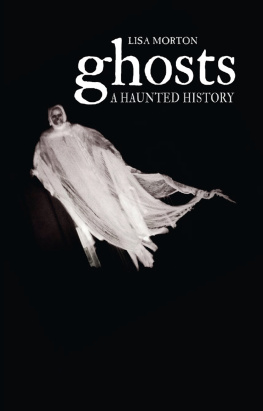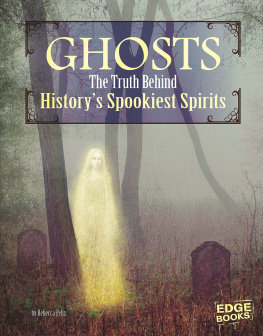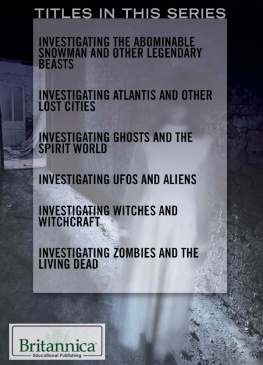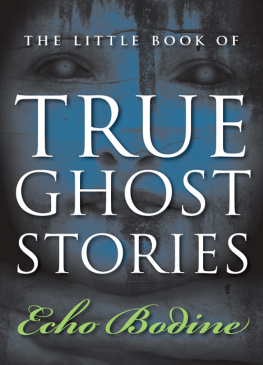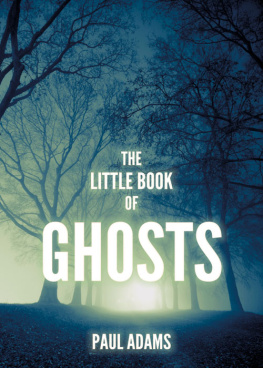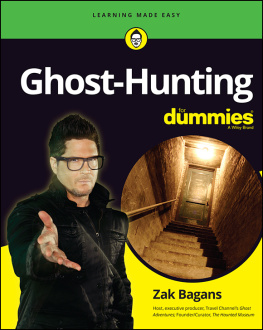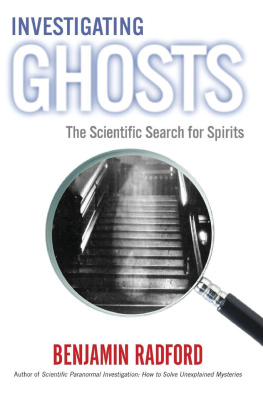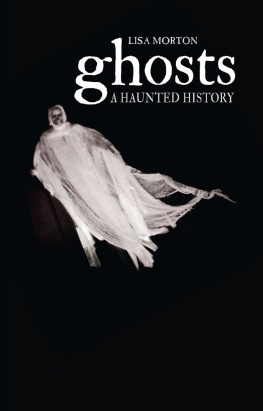ghosts

LISA MORTON
ghosts
A HAUNTED HISTORY
REAKTION BOOKS
Published by
Reaktion Books Ltd
33 Great Sutton Street
London EC1V 0DX, UK
www.reaktionbooks.co.uk
First published 2015
Copyright Lisa Morton 2015
All rights reserved
No part of this publication may be reproduced, stored in a retrieval system, or transmitted, in any form or by any means, electronic, mechanical, photocopying, recording or otherwise, without the prior permission of the publishers
Page references in the Photo Acknowledgements and
Index match the printed edition of this book.
Printed and bound in China by Toppan Printing Co. Ltd
A catalogue record for this book is available from the British Library
eISBN: 9781780235370
Contents

Halloween ghost decoration, Studio City, California, 2012.
Introduction
On a gloomy autumn day, as dead leaves scud around your feet and a chill breeze finds its way under your collar, you approach the house in which you grew up. Its a month since your father was laid to rest in the family plot beside your mother. Youve dealt with relatives and the funeral and the initial bills, youve mourned and have come to accept that hes gone, and now you have to settle his estate.
You moved out of this house twenty years ago, and even though youve visited many times since, it feels strange now, almost alien. You see, as if for the first time, how run-down it is the white paint is peeling, the old oak tree in the front garden is dying, the fence is in bad need of repair.
It isnt until you enter the house, however, that the melancholy really hits you. The house smells of sickness the long, damnable disease that finally took your father and its cold, since the heating hasnt been on for a month. There are shadows everywhere, and even though you know everything in this house (theres the shelf of books you read a dozen times, heres the table they said your great-grandfather made), youve never been alone here as an adult, and an inexplicable shiver races through you.
The stairs creak as you climb them. A pipe groans as a stray breeze passes through it. Your old room still has posters from your adolescence, and this at least offers some comfort. You fall back on the bed, close your eyes
And awaken to the sure knowledge that someone is in the room.
Its dark now, nearly full night, and the room is chilled. Over by the window, limned by the faint glow of streetlights, is a figure. You hold your breath, paralysed by fear; you cant move, cant even cry out. The dim apparition turns to you, your heart hammers and suddenly youre alone. The room warms again, and it takes you a few seconds to realize the lingering scent in the air is your fathers aftershave.
Youve just met something you can describe only as a ghost. Your experience is so common throughout all times and regions of human history that its close to being universal and yet no solid proof has ever been offered to prove the existence of life after death. Nearly half of all Americans currently believe in ghosts (and more than a third believe they have lived in a haunted house), and in other countries belief runs even higher (for example, 87 per cent of Taiwans office workers believe in them). Ghosts are found in everything from classic literature to contemporary reality television shows, and yet even defining ghosts is surprisingly difficult and a source of debate among aficionados. The English ghost-hunter Peter Underwood described ten types of ghost, including haunted objects, elementals (ghosts connected to particular locations these often provoke severe reactions, such as insanity, in onlookers) and ghosts of the living (see, for example, the Scottish belief in the fetch, an apparition of a living individual that might appear to a loved one as an omen or warning).
The ghost, in the classic sense, is thought to be the spirit of someone who has died. Encounters with ghosts are as in the scenario that opened this introduction often connected to architecture and family ties, especially those that are wrapped up in grief, and may include cold spots (an area of a house or room where the temperature is inexplicably lower), rapping or banging sounds, music, smells and the sensation of being touched.
As humanity has spread and changed, so have its ghost beliefs. Improvements in science and technology have allowed us to investigate the nature of ghosts; while some investigators have sought to use new devices to capture proof of the existence of the frustratingly elusive undead, others have experimented with the human brain in an effort to find non-supernatural explanations for ghosts. Mental illness, repressed trauma, the hypnagogic state experienced between sleep and wakefulness, electromagnetic fields and extreme low-frequency infrasound have all been advanced as theories to explain the experience of encountering a ghost, although a single explanation has yet to be widely accepted or at least as widely accepted as the notion that a ghost is a spirit of the dead.

Haunted clause from a standard American real estate disclosure agreement, 2014.
If ghosts are, in fact, no more than hallucinations, perhaps brought about by exposure to insufficient electrical shielding or certain inaudible low-frequency sound waves, then the question remains: why do these visions so often take the form of a foggy human shape, one that occasionally coalesces and assumes the features of someone we know, usually a deceased loved one? And why are these encounters almost always so terrifying? Wouldnt meeting a dead spouse or sibling be wondrous, even joyous in revealing the existence of an afterlife? In her nineteenth-century classic The Night-side of Nature, the writer Catherine Crowe suggests that the fear of ghosts arises simply from bad training, while the Spiritualism movement that her book influenced also sought out ghosts as a source of enlightenment. Yet, by the end of that century, fiction writers such as Charles Dickens, F. Marion Crawford and M. R. James had returned the ghost to the realm of the frightening.
Surely it is no coincidence that throughout humankinds written history, ghost stories have been prevalent in religion, mythology and literature. Our earliest recorded epics Gilgamesh, The Odyssey all combine heroic journeys with frightening visits from ghosts. Ghost stories have often been associated with war which is, after all, an activity that often leads to death and soldiers make for unassailably stalwart and honest protagonists in ghost stories (as do lawyers, doctors and ministers of the church).
Ghosts have been institutionalized and turned into festivals Chinas Hungry Ghost Festival, or Mexicos Dias de los Muertos and by the eighteenth century the ghost story was an established genre of Western literature. Gothic writers like Ann Radcliffe (whose hauntings were all revealed as hoaxes by the end of each of her novels) and Horace Walpole popularized ghost stories even more, and paved the way for later writers such as Dickens (A Christmas Carol may be the most famous ghost story of all time) and Bram Stoker, who applied many of the techniques of the classic ghost story to eastern European vampire folklore, creating

